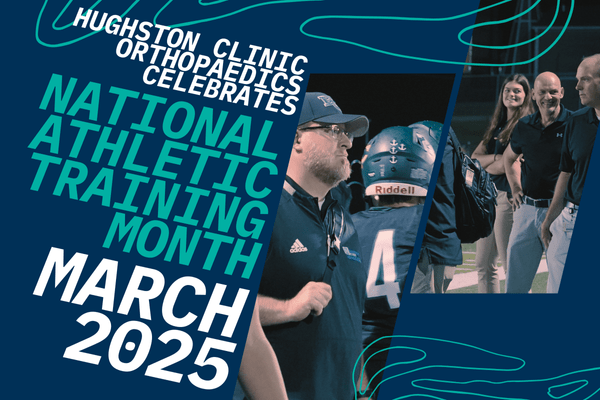
Hughston Clinic Orthopaedics just wrapped up celebrating National Athletic Training Month for March! Nathan Johnson, Director of Athletic Training for Hughston Clinic Orthopaedics shared some great information with us about his career path and little-known facts about the profession.
GET TO KNOW NATHAN JOHNSON
My dad went with me to a college fair my senior year of high school. I talked with the admissions person from Cumberland University. That person set up a meeting for my parents and me to meet with Athletic Training Program Director Steve Corey. He painted a picture of athletic training and the future of the profession. I was hooked.
2025 is my 25th year of being a certified athletic trainer, so maybe I’m doing something right.
I was intrigued by athletic training/sports medicine because it combined my desire to help people with my love of athletics. My inspiration comes from helping people. I work in the secondary school setting. When I began my career at Friendship Christian School, I wanted to get some experience then move into collegiate athletics. After all these years, I continue to work with Friendship Christian School. I believe I have had a positive impact on people at FCS and Wilson County.
I figured out early on in my career how much of an impact an athletic trainer can have with the middle school and high school age group. In this profession, you see athletes at some of the worst moments in their lives. When the injury happens, you (the athletic trainer) are there from initial injury onset until that athlete returns to play.
For my patients and athletes, I am there to listen, to educate, and to help them through treatments, rehab, and the healing process. Then, you get to be there with them when they return to participating in their sport or activity. It is a full circle moment for you and them. My favorite part is watching a student athlete return to play after an injury. When the athlete smiles and says thank you—that is the reward.
FACTS ABOUT ATHLETIC TRAINING from Nathan Johnson
Some people see athletic trainers during an event and think that person is just watching the game. They don’t see the 2 to 4 hours of work an athletic trainer puts in before the event to make sure the athletes are ready to participate.
People don’t see the 2 to 4 hours after the event that is spent treating the chronic injuries, evaluating any new injuries, and planning for the next week to make sure the athlete/patient can safely continue to participate.
People don’t see the hours an athletic trainer puts in conducting pre- and post-practice treatments and rehabs, communicating between athletes and parents, doctors, and coaches, encouraging and counseling athletes and families, and advocating for injured athletes.
Athletic trainers are highly qualified, multi-skilled healthcare providers who work under the supervision of a physician.
Athletic Trainers are skilled in injury prevention, emergency care, evaluation and treatment of injuries, concussion management, and rehabilitation of injuries.
There are more than 56,000 athletic trainers worldwide.
Athletic trainers work in a variety of environments outside of the traditional athletic setting including industrial, military, NASA, theme parks, dance competitions, and more.
Athletic trainers are unique healthcare providers who follow a medical-based education model from an accredited program.
Athletic trainers must pass a national certification exam and be licensed in the state where they intend to practice.
Please follow along on social media for more features, updates, and information!
Last edited on May 6, 2025